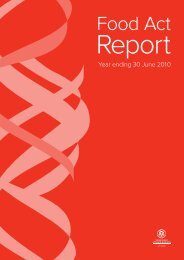Public Health and Communicable Diseases - SA Health - SA.Gov.au
Public Health and Communicable Diseases - SA Health - SA.Gov.au
Public Health and Communicable Diseases - SA Health - SA.Gov.au
You also want an ePaper? Increase the reach of your titles
YUMPU automatically turns print PDFs into web optimized ePapers that Google loves.
Early treatment of infections is essential in reducingtransmission of infection. This may be achieved throughhealth promotion <strong>and</strong> promotion of good health seekingbehaviour. Most individuals with infections are identifiedthrough screening <strong>and</strong> not as a result of havingsymptoms, hence screening of susceptible personsneeds to be continued <strong>and</strong> opportunistic screeningshould be encouraged.In order to make a difference a coordinated multisectoralapproach addressing many different factorsis necessary. There is an urgent need to coordinateeducational activities with the Department of Education<strong>and</strong> to liaise with those working in the field of alcohol<strong>and</strong> other drugs to address the issue of substancemisuse <strong>and</strong> STI transmission.There is a great void in our knowledge concerningsexual behaviour <strong>and</strong> sexual networking in CentralAustralian indigenous communities. In order to develop<strong>and</strong> disseminate appropriate safer sexual behaviourmessages there is a need to underst<strong>and</strong> current normsin the area. Social <strong>and</strong> behavioural research needs to beconducted in this area.Finally, condoms should be accessible <strong>and</strong> freelyavailable in communities <strong>and</strong> there is a need to explorethe acceptability of female condoms to give women anopportunity to exercise greater control of their sexualhealth.References1. National Centre in HIV Epidemiology <strong>and</strong> ClinicalResearch. HIV/AIDS, viral hepatitis <strong>and</strong> sexuallytransmissible infections in Australia AnnualSurveillance Report 2005. National Centre in HIVEpidemiology <strong>and</strong> Clinical Research, The Universityof New South Wales, Sydney, NSW. Canberra, ACT:Australian Institute of <strong>Health</strong> <strong>and</strong> Welfare; 2005.2. World <strong>Health</strong> Organization Global Programme on AIDSmanagement of Sexually Transmitted <strong>Diseases</strong>.WHO/GPA/TEM/94.1. Geneva; 1994.3. Latif AS, Smith KS. STI screening conducted in NTDepartment of <strong>Health</strong> <strong>and</strong> Community Services <strong>and</strong>Community Controlled <strong>Health</strong> Services in CentralAustralia in 2004. NT Disease Control Bulletin. Centrefor Disease Control, NT Department of <strong>Health</strong> <strong>and</strong>Community Services. 2004;11:18-20.4. Miller PJ, Law M, Torzillo PJ, Kaldor J. Incident sexuallytransmitted infections <strong>and</strong> their risk factors in anAboriginal community in Australia: a population basedcohort study. Sex Transm Inf. 2001;77:21–25.5. Warchivker I, Japangati T, Wakerman J. The turmoilof Aboriginal enumeration: mobility <strong>and</strong> servicepopulation analysis in a central Australian community.Aust NZ J <strong>Public</strong> <strong>Health</strong>. 2000;4:444-449.6. Tangey A. Report on STI Screen. Sexual <strong>and</strong>reproductive health program. Ngaanyatjarra <strong>Health</strong>Service; 2004.7. Nganampa <strong>Health</strong> Council. Annual Report 2005.Alice Springs; 2005. Available from: http://www.nganampahealth.com.<strong>au</strong>34The Impact of <strong>Health</strong>Care AssociatedInfectionIrene WilkinsonManager, Infection Control Service,<strong>Communicable</strong> Disease Control Branch.<strong>Health</strong>care associated infections (HAI) have long beenrecognised as a critical problem affecting the quality ofhealth care <strong>and</strong> are a principal source of adverse healthcare outcomes in Australian hospitals. 1 In overseasstudies, they have been shown to lead to increasedpatient morbidity <strong>and</strong> mortality, resulting in increasedlength of hospital stay, <strong>and</strong> additional diagnostictesting <strong>and</strong> treatment, with consequent increasedcosts to the health system. 2 In 1992 it was estimatedthat in the United States HAI affected over 2 millionpatients annually, at a cost in excess of $4.5 billion <strong>and</strong>have been reported to account for 50% of all majorcomplications of hospitalisation. 3In 1999 the U<strong>SA</strong> National Institutes of <strong>Health</strong> publisheda report entitled “To Err is Human” which addressed theincidence <strong>and</strong> impact of adverse events in healthcare, ofwhich HAI were a major contributor. 4 During the sameyear, the Department of <strong>Health</strong> in Britain published areport entitled “The Socio-Economic Burden of HospitalAcquired Infection”. 5 The aim of this study was to assessthe burden of HAI in terms of the costs to the publicsector, patients, informal carers <strong>and</strong> society as a whole.The researchers found that 7.8% of patients experienceda healthcare associated infection whilst still an in-patient,<strong>and</strong> a further 19.1% of surveyed patients experienceda possible HAI after discharge from hospital. Byextrapolation, HAI were estimated to cost the NHS £986million annually, of which £930 million was incurredduring the patients’ hospital stay <strong>and</strong> £56 million (or 6%of the total cost) was incurred post-discharge.There are little data on the cost of HAI in Australia,but recent estimates are provided in a report fromthe Expert Working Group of the Australian InfectionControl Association to the Commonwealth Departmentof <strong>Health</strong> <strong>and</strong> Ageing. 6 It is estimated that surgical siteinfections could be costing as much as $268 million peryear <strong>and</strong> that the total costs to the health care systemfor bloodstream infection may be as high as $686million. However, these figures should be viewed withc<strong>au</strong>tion, since the lack of comprehensive surveillancedata in Australia make the estimation of the total burdenproblematic. There is little known about the relativecontribution of out-of-hospital expenses <strong>and</strong> societalcosts to the overall costs of nosocomial infection in
















